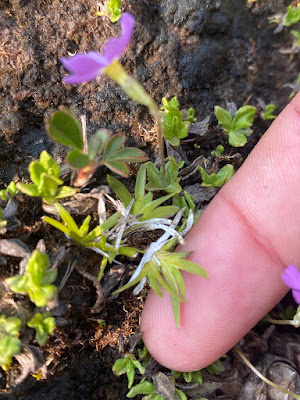Lichens and Lichenicolous Fungi of Grand Marais
I spent most of the day out looking for lichen in and around Grand Marais. There were a few things that I observed earlier in the year that I was curious how distributed they are in the area, today seemed like a good day for an adventure up north.
The first and most interesting stop was of course at Artists' Point. It is a tied island connected to the mainland by a tombolo. This is quite a unique feature along the shoreline, the only other example that I've noticed is at Sugarloaf Cove. Both places are small islands by most standards, but they are quite large when compared to other islands along Superior's North Shore. Both places house some extremely rare plants and lichens. They also provide an absolutely breathtaking view of Superior. Sadly, these locations (especially Artists' Point) are favorites of tourists and these rare communities get quite trampled. Historically, there was a population of the endangered Scottish asphodel (Tofieldia pusilla) at this location. Sam Guida last observed this population in 2021 and has been unable to find it since then. I haven't looked for it at this site, but it is presumed to be extirpated. This species is very very small, maybe there is still one or two plants eking out a living here. How long will some of these other rare species hang on before also succumbing to human disturbance?
My main objective was to find Arthrorhaphis grisea (or maybe it's Sclerococcum athallinum), a lichenicolous fungi that I saw earlier this year growing on brown berret lichen (Baeomyces rufus). Last time I only saw it on one small patch of the lichen growing on a shaded boulder. This time I saw it growing in a few places. To my knowledge you need to observe spores under a microscope to be able to differentiate the two species. I hope that someone will do that at some point for this population. Both species appear to have a pretty limited range in North America (or have yet to be observed in places where they occur), either way its a cool find. Other interesting observations included Abrothallus peyritschii and Pisutiella grimmiae. I also saw wooden soldiers lichen (Cladonia botrytes) for the first time. It looks very similar to the more common (and was even growing right next to) British soldiers lichen (Cladonia cristatella). Wooden soldiers has a pale whiteish apothecia, whereas British soldiers has a striking red one. A little bit further down the shore I also saw Punctelia stictica and Illosporiopsis christiansenii. It's amazing all the rare, interesting things you can see if you just slow down and focus enough to notice them. Of course being in an extremely unique place helps as well.












Comments
Post a Comment